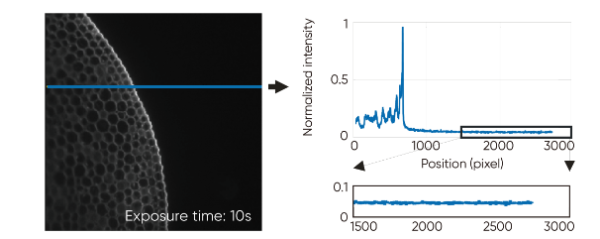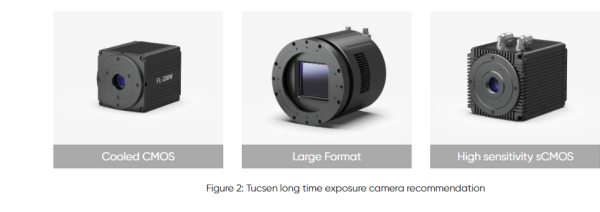Dark current is a camera noise source that is temperature- and exposure-time-dependent, measured in electrons per pixel, per second of exposure time. For applications using exposure times of less than one second, with dark current less than 1e-/p/s, it can typically be ignored in signal-to-noise-ratio calculations.
For example, at a dark current value of 0.001 e/p/s, exposure times of 1ms or 60 seconds both lead to negligible noise contribution, where the noise value is given by the dark current value multiplied by the exposure time, all under a square root. However, a different camera with 2e-/p/s at 60s exposure would contribute an additional √120 = 11e- of dark current noise, which may be far more significant than the read noise at low light levels. Still, at 1ms exposure, even this higher dark current level would be negligible.

Figure 1: The Figure 1(a) comes from Tucsen cooled CMOS camera FL 20BW that the dark current is as low as 0.001e/pixel/s. The Figure 1(b) shows that the Figure 1(a) has a excellent background which almost immune to dark current noise though the exposure time is as long as 10s.
Dark current noise is caused by the thermal motion of electrons within the camera sensor. All atoms experience thermal vibrational motion, and occasionally an electron can ‘jump’ out of the camera sensor’s substrate into a the pixel well where detected photoelectrons are stored. It is impossible to distinguish between these ‘thermal’ electrons and electrons that have arisen through the successful detection of a photon. During the exposure of an image, these thermal electrons can build up, contributing to a background dark current signal. However, the precise number of electrons is random, leading to the contribution of dark current noise. At the end of the exposure, all charges are measured cleared from the pixel ready for the next exposure.
Dark current noise is temperature dependent, but it is also highly dependent upon the camera sensor’s design and architecture and camera electronics, so can vary greatly from camera to camera at the same sensor temperature.
Is low dark current important for imaging? Whether a given dark current value will contribute significantly to your images’ signal-to-noise ratio and image quality depends entirely upon your imaging scenario.
For high-light imaging scenarios with thousands of photons per pixel after a camera exposure, dark current is highly unlikely to be significant in image quality unless exposure times are very long (tens of seconds to minutes) such as in astronomy applications.

Media Contact
Company Name: Tucsen
Email: Send Email
Phone: +86 591 28055080
Country: China
Website: https://www.tucsen.com/
